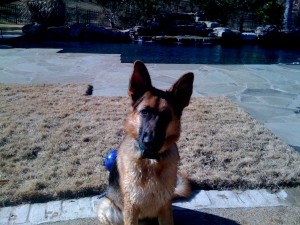 If you want to control your pet dog’s involuntary aggressive responses via force and intimidation, you are entering a spiral of blackness and doom.
If you want to control your pet dog’s involuntary aggressive responses via force and intimidation, you are entering a spiral of blackness and doom.
One day, your chosen method or equipment will fail; injuries and sadness will emerge. I’ve seen it many times.
Point being, punishing the growl with a quick burst of energy via an e-collar, leash jerk, Caesar Milan hiss, alpha roll, spank on the butt, or verbal reprimand, does nothing to change underlying, emotional reasons for the growl. In many cases, the aggression increases, because the naughty dog associates other dogs or strangers with the discomfort.
You may very well stop your dog from growling with one of many punishment techniques, that I do not deny. (Success via corrections really depends on the underlying causes, but that is a topic for another day.)
But, you just signed a life long commitment to supervise every interaction your dog has with strangers or other dogs. You will constantly have to prove to your dog that you are a superior warrior. And you have made your task of supervision much more difficult.
If you zap your dog every time he or she growls or gives another animal the “eye”, you will negate your observation skills, because your dog will skip the body posturing and growling (the obvious, observable behaviors that indicate a problem), and go straight to the bite.
If you are using a training collar, e collar, shock collar, or any other special equipment, your dog must always be fitted with the equipment, and you must always be ready to use the equipment.
All you’ve done is remove the warning, the very warning that lets you know something is wrong, the very warning that tells you to take action to avoid an incident.
It’s like placing a black tape mask over a check engine warning lamp on your car’s dashboard. Great, now you don’t see the warning, therefore the problem is resolved?!
I’m not one of those “never ever use a shock collar or leash jerk” kind of people. I realize there are times when corrections are helpful. Shock collars, leash jerks, or verbal reprimands may be useful tools within a behavior modification program designed by a canine behavior counselor.
If your behavior modification plan includes rewards, obedience training, classical conditioning, and changing the dog’s perception, you can change the underlying reason your dog is aggressive.
If your only solution to stop your dog from attacking other dogs or strangers is the use of corrections, truth is, you would benefit from a bit of help. You should contact a canine reactive behavior specialist.
None of this comes to anyone in a dream. I was ignorant until I began my studies about animal learning, behavior, and canine behavior modification. I made all the same “logical” assumptions about controlling dogs via corrections and intimidation. If you are not familiar with basic concepts of instrumental conditioning, you should never use a shock collar to stop your dog from behaving aggressively. Your ignorance will bite you.
Real Life Example:
In my neighborhood there is a large breed dog who has been naughty towards other dogs. (I’ll omit the breed, because it has no relevance to this story). The owner uses a shock collar to punish Naughty Dog’s aggressive behaviors. The owner’s mom was walking Naughty Dog, without the shock collar, and has been doing so for months, with no incidents of aggression. A few days ago, the honeymoon ended. The lady who was walking Naughty Dog was passing another leashed dog on the street. Naughty Dog did not growl or send any signals that he was about to attack. The lady was caught off guard when Naughty Dog suddenly attacked the passing adult male dog. The lady was bitten in the face when she tried to break up the dog fight.
If the owner had not used a shock collar to punish the aggression, the Naughty Dog would have postured or growled, and the lady could have seen what was about to happen. She could have avoided the situation. But Naughty Dog “attacked without warning”, which ironically, perplexed the owner. The owner has no idea that he was directly responsible for Naughty Dog’s lack of warning signals.
P.S. The German Shepherd Dog in the picture, Samantha, is not Naughty Dog!
Happy Training!
Alan J Turner How’s Bentley Memhis TN

